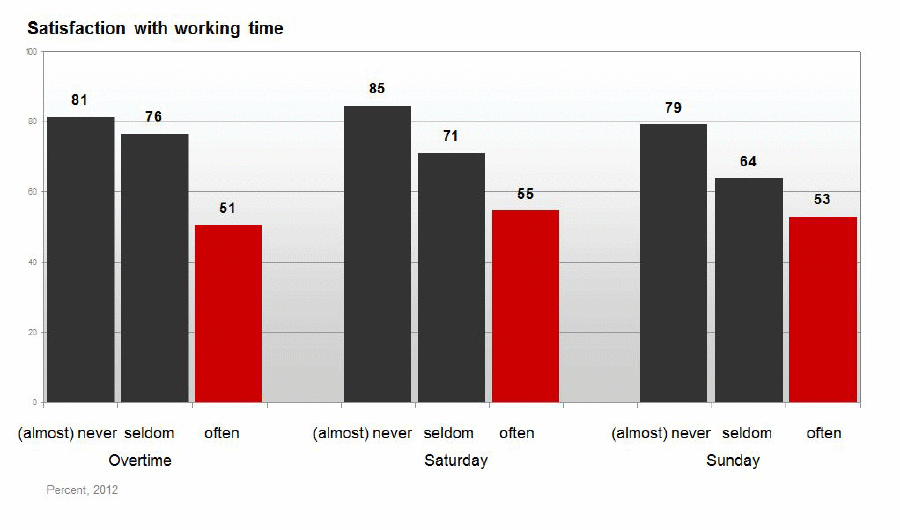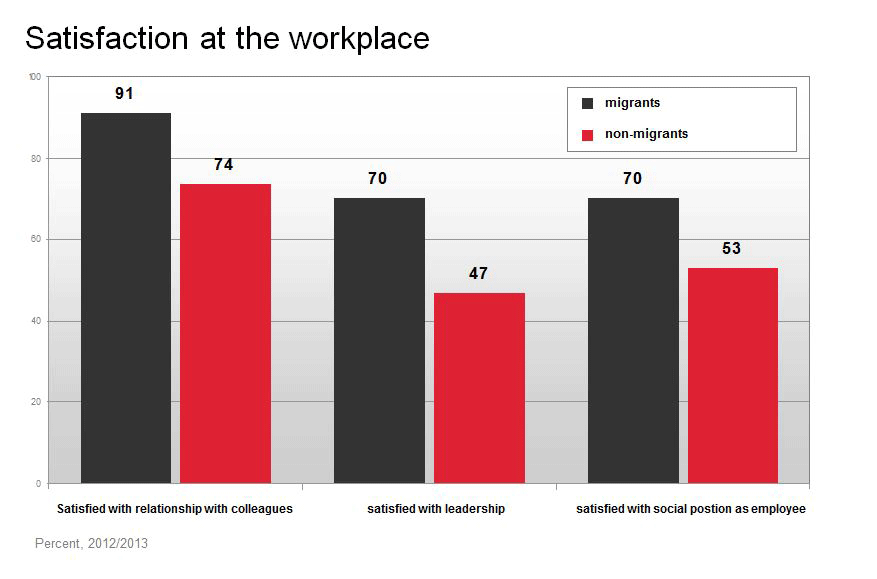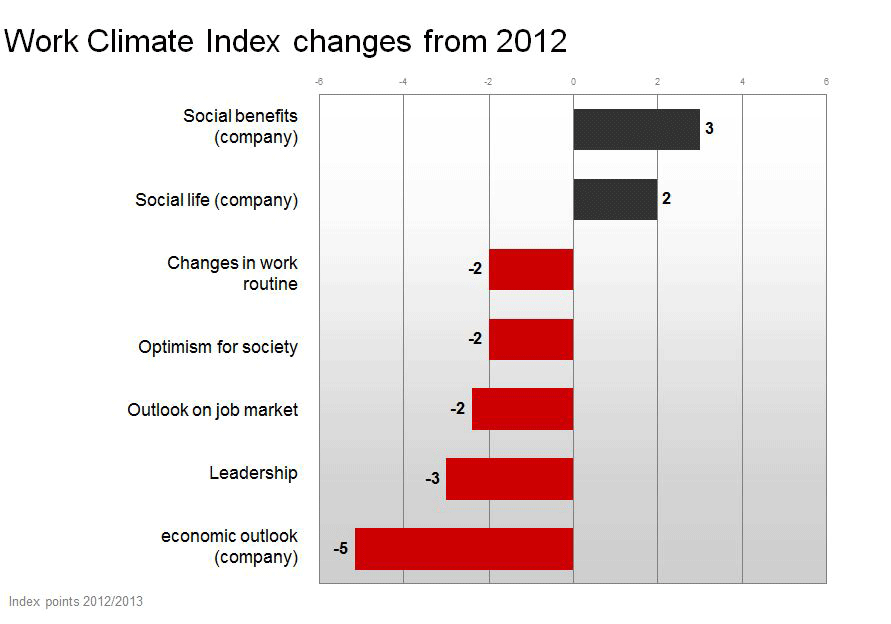Dieses Bild teilen über:
The discussion about overtime, working on weekends and public holidays is going on and on. Exponents of the economy agree with overtime hours, and some of them even endorse longer shopping hours. The trade unions and the Chamber of Labour disapprove of this. What about the satisfaction of Austrian employees with working hours according to the Work Climate Index?
Compared to 2007/2008, the sub-dimension "time management" (satisfaction with working time regulation and work-life balance) has dropped by several points to currently 76. Satisfaction with working time regulation, in particular, is declining: whereas it was always above 80 percent up to the second half of 2008, it has meanwhile dropped to currently 74 percent.
More than two thirds of the employees work overtime sometimes (53 percent) or frequently (15 percent).
The share of employees working on Saturdays or Sundays has been rising conspicuously for about one year: in spring 2012, 17 percent said they had to work on Saturdays frequently, now this percentage is 22. A year ago, nine percent stated they had to work on Sundays frequently, now this share has risen to 12 percent. For young women, in particular, working on Saturdays is a normal part of their working life: 38 percent of all women up to the age of 25 say they have to work on Saturdays frequently. This means that almost four out of ten women up to 25 years old work on Saturdays on a regular basis. By comparison: among young men the percentage is only half as high - 19 percent of the men under 26 years of age say they have to work on Saturdays frequently.
Employees who have to work on Saturdays or Sundays frequently achieve clearly lower values in the Work Climate Index. The Work Climate Index of employees having to work on Saturdays frequently is 102 points, the index of those having to work on Sundays is 101 points (overall index 108 points).
The same applies to employees who have to work at nights or do overtime frequently. They are less satisfied, more pressed for time, suffer from higher physical and psychological stress, and have a harder time finding a good work-life balance.

The developments taking place on the Austrian labour market and in companies are starting to show more and more in the details of the Work Climate Index.
For example, the sub-dimension "time management" - dealing with the satisfaction with working hours and the assessment of the work-life balance - has reached its lowest level again, being at 76 points. The increased need to work on weekends and public holidays - mainly for (younger) women - has a lot to do with it.
In some cases, satisfaction with the leadership of superiors has clearly declined. A lot has been written but little seems to be done about modern and better leadership.
The employees most concerned by this are those with lower qualifications and with a migration background. The high dissatisfaction with the leadership of superiors in these two groups has a strong impact on job satisfaction in general and, in the end, probably on the quality of work. Entrepreneurs should be well aware of this.
Austrian employees are largely satisfied with their colleagues, but clearly less satisfied with the leadership of their superiors.
About eight out of ten Austrian employees are satisfied with the kind and content of their professional activities, 41 percent of them are even very satisfied. Factors like the work environment may play a substantial role in general job satisfaction.
The social environment or social situation refers to both the specific work environment in the company (colleagues, superiors) and the subjective situation as an employee in society as a whole.
88 percent of the Austrian employees are very satisfied or rather satisfied with their colleagues. Though this value has declined a little (from 93 percent 10 years ago), it has remained largely stable since 2008.
Currently, 67 percent of the employees are satisfied with the leadership of their superiors. The last time this value was this low was in autumn 2010, and before that in spring 2004.
Satisfaction with the social situation as an employee has declined since 2007, although the index has risen by two percentage points in the last half year. At present, 67 percent of wage earners in Austria are very satisfied or rather satisfied. Some years ago, this percentage was more than 75 percent. Employees with lower qualifications, in particular, and among them mainly the older ones and blue-collar workers, are less satisfied with their social situation.
91 percent of all employees without a migration background are satisfied with their colleagues, but only 74 percent of those with a migration background. 70 percent of the employees without a migration background are satisfied with leadership and their social situation in society, but only 47 and 53 percent, respectively, of the migrants. These results reflect the difficult working atmosphere for migrants in Austria, and also their difficult social situation.

The digital change getting faster and faster creates new occupational prospects but also stress caused by pressure of time, mental pressure and bad leadership. Employees in the IT industry are male, younger, and well qualified. What is the professional situation of programmers and computer engineers? The Work Climate Index has some answers.
The clear majority (81 percent) is employed, seven percent are "independent contractors", six percent work in the public sector and/or as blue-collar workers. 72 percent work as qualified employees. Five percent, each, are senior executives or work in "the professions".
The majority of the employees in the IT industry are male, only eleven percent are women. 60 percent are less than 36 years old. 64 percent have a university entrance diploma, 36 of them a degree from a university or a university of applied sciences. Only eight percent have a migration background.
The employees in the IT industry are more satisfied with most aspects of their professional lives than employees of other lines of business. 91 percent are satisfied with the kind and content of their professional activities. Clearly more employees in the IT industry than the average of all other industries are also satisfied with income, training, career and development opportunities.
But: Only 67 percent are satisfied with the leadership of the superiors, which is two percent below the employees of other industries. Only one third has fixed working hours, 26 percent work overtime frequently, 46 percent sometimes.
Pressure of time means high stress for 24 percent of the employees in the IT industry. But with this value they are still clearly below the other branches of trade (36 percent stressed).
Other stress factors in the IT industry: psychologically stressful work (ten percent), as well as technical and organizational changes (eleven percent).
Economic and socio-political discussions are full of figures and data focusing on how the welfare state is downsized and distributive justice is diminished.
The Austrian Work Climate Index is a benchmark for economic and social change from the employees' point of view. It examines their assessment with respect to society, company, work and expectations. Other than the usual key figures regarding economic development, the Work Climate Index captures the subjective dimension, expanding the knowledge of economic developments and their implications for society.
The calculation of the Work Climate Index is based on quarterly surveys taken among Austrian employees. The random sample of approx. 4000 respondents each year is selected with a view to being representative so as to enable telling conclusions regarding the mental state of all employees. Since the spring of 1997, the Work Climate Index has been calculated twice a year. There are also supplementary special evaluations.
For current results and background information please refer to www.arbeitsklima.at. There you’ll not only find the comprehensive work climate database for evaluation, but it’s also possible to calculate your personal satisfaction index with your workplace online within just a few minutes.
Follow us on Twitter: twitter.com/AK_Arbeitsklima
In early May the Public Employment Service Austria announced that, by the end of April, 353,000 people in Austria were either seeking work or attending training measures. Compared to April last year this means an increase by ten percent.
Seven percent of those working at least half-time stated in the Work Climate Index that they were unemployed at least once in the last 12 months - even if only for a short time. In autumn 2012 this value was six percent, one year ago five percent. Younger people, migrants, and people with only minimum compulsory schooling were unemployed more often. Many of the new jobs they found are only part-time jobs. More and more people are employed for only 20 hours a week at maximum. Only one third of all persons stating they were unemployed last year have a full-time job at present - compared to 61 percent one year ago.
The increasing unemployment rate dampens the mood of the Austrian employees, especially where the question of further economic development and - along with it - that of job security is concerned.
The values in the sub-dimensions "chances on the job market", "optimism for society", and "economic future of the company" are declining. It seems as if little has changed in the past two years as regards the Austrians’ job satisfaction. The Work Climate Index has been stagnant at 108 points. The partial indices, too, have hardly changed compared to autumn 2012.
The sub-dimensions of job satisfaction show some changes. It is mainly the future perspective of the Austrian employees that are slowly darkening again. The index value in the field "chances on the job market" has dropped by two points, in the field "optimism for society" also by 2 points, and in the field "economic future of the company" even by five points.
Only 58 percent of the employees are optimistic when it comes to the economic future of the country (minus six percentage points), and 81 percent when it comes to the company (minus four). 45 percent regard the jobs in Austria as insecure (plus four percentage points).
Employees with lower qualifications, in particular, i.e. those with only minimum compulsory schooling worry about their jobs. Only 15 percent are sure to keep their jobs, which means a decline by five percentage points since autumn 2012.

© 2026 AK Oberösterreich | Volksgartenstrasse 40 4020 Linz, +43 50 6906 0